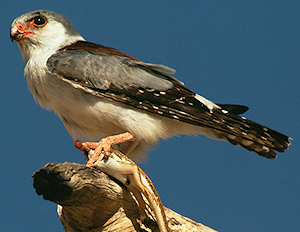African Pygmy Falcon Facts

Name: African Pygmy Falcon (Pygmy Falcon)
Scientific Name: Polihierax semitorquatus
African Names: Ndege (Kiswahili)
 Length: 7 3/4 inches
Length: 7 3/4 inches
Wingspan: 14 1/2 inches
Average Adult Weight: 2 ounces to 2 1/2 ounces
Life Span: The lifespan of the African Pygmy Falcon is through to be 6 to 8 years with a maximum lifespan of 20 years.
Description: Adult Pygmy Falcons are white underneath and grey above. The female has a chestnut back. They have white "eye spots" on the nape. The wings are spotted black and white. The tail is barred black and white.
Habitat: African Pygmy Falcons prefer arid and semi-arid steppes with sparse vegetation and some large trees or plants.
The East African Pygmy Falcon nests in White-headed Buffalo-weaver nests and in Southern African they nest in Red-billed Buffalo-weaver nests as well as in the vacant rooms of Sociable Weaver nests.
Countries found in: The African pygmy falcon has two separate populations. One is in east Africa in Ethiopia, Kenya, Somalia, Sudan, Southern Sudan, Uganda, and Tanzania. The other population is in South Africa, Angola, Namibia, and Botswana.
Babies: Three eggs are normally laid in a nest. Incubation lasts from 28 to 30 days. Both parents help to incubate the eggs. The chicks fledge sometime between 27 to 40 days but remain in the area of the nest for up to 2 months after leaving the nest.
Food: African Pygmy Falcons eat on small lizards, rodents, birds, and large insects.
Group Name: Flock or cast of falcons
Habits: At times more than one pair of falcons will inhabit a nest. Ther are several reasons for this behavior - defneding the nest, keeping warm during cold spells, and delaying the dispersal of offspring.
Conservation Status: Least Concern
Predators: Occassionally, the chicks of the African Pygmy Falcon may be attacked, however as a general rule they do not have any predators.
Interesting Facts: The African Pygmy Falcon is the smallest falcon of the African continent.
These birds use the large communal nest masses of weaver birds as roosting and nesting sites.
Scientific Name: Polihierax semitorquatus
African Names: Ndege (Kiswahili)
 Length: 7 3/4 inches
Length: 7 3/4 inches Wingspan: 14 1/2 inches
Average Adult Weight: 2 ounces to 2 1/2 ounces
Life Span: The lifespan of the African Pygmy Falcon is through to be 6 to 8 years with a maximum lifespan of 20 years.
Description: Adult Pygmy Falcons are white underneath and grey above. The female has a chestnut back. They have white "eye spots" on the nape. The wings are spotted black and white. The tail is barred black and white.
Habitat: African Pygmy Falcons prefer arid and semi-arid steppes with sparse vegetation and some large trees or plants.
The East African Pygmy Falcon nests in White-headed Buffalo-weaver nests and in Southern African they nest in Red-billed Buffalo-weaver nests as well as in the vacant rooms of Sociable Weaver nests.
Countries found in: The African pygmy falcon has two separate populations. One is in east Africa in Ethiopia, Kenya, Somalia, Sudan, Southern Sudan, Uganda, and Tanzania. The other population is in South Africa, Angola, Namibia, and Botswana.
Babies: Three eggs are normally laid in a nest. Incubation lasts from 28 to 30 days. Both parents help to incubate the eggs. The chicks fledge sometime between 27 to 40 days but remain in the area of the nest for up to 2 months after leaving the nest.
Food: African Pygmy Falcons eat on small lizards, rodents, birds, and large insects.
Group Name: Flock or cast of falcons
Habits: At times more than one pair of falcons will inhabit a nest. Ther are several reasons for this behavior - defneding the nest, keeping warm during cold spells, and delaying the dispersal of offspring.
Conservation Status: Least Concern
Predators: Occassionally, the chicks of the African Pygmy Falcon may be attacked, however as a general rule they do not have any predators.
Interesting Facts: The African Pygmy Falcon is the smallest falcon of the African continent.
These birds use the large communal nest masses of weaver birds as roosting and nesting sites.
This site needs an editor - click to learn more!
You Should Also Read:
Abyssinian Ground Hornbill Facts
Eurasian Widgeon Facts
Wattled Crane Facts
Related Articles
Editor's Picks Articles
Top Ten Articles
Previous Features
Site Map
Content copyright © 2023 by Jeanne Egbosiuba Ukwendu. All rights reserved.
This content was written by Jeanne Egbosiuba Ukwendu. If you wish to use this content in any manner, you need written permission. Contact
BellaOnline Administration
for details.


